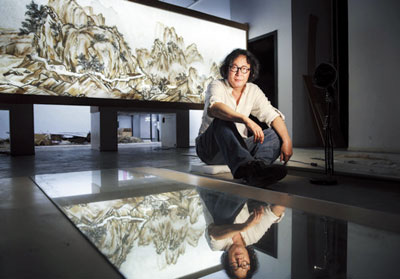 FOR the first time in Italy, the strength of Chinese characters in the works of a leading artist was central to an exhibition that kicked off Saturday at the Palazzo dell’Arte (Palace of Art), the headquarters of the Triennale Art Institution. Xu Bing, born in Chongqing in 1955, is one of China’s most acclaimed living artists. His “Character of Characters,” a video animation illustrating the birth and relation of Chinese characters with human history, was the starting point of this project aimed at making the excellence of Chinese art known to a Western audience, curator Hans de Wolf said at the exhibition preview. “The idea for this exhibition came to me a couple of years ago, when I saw for the first time this absolute masterpiece of Xu Bing at the Central Academy of Fine Arts in Beijing,” de Wolf recalled. “For me it was a moment of inspiration. I understood immediately the extreme quality of this artwork.” Also in 2013, the Venice Biennale welcomed more than 100 Chinese artists who received no attention, a sign that Western audiences were not much aware of the fact that in China there were excellent artists, de Wolf said. “That is why I decided to put Xu Bing at the center of an exhibition that gathered other artists from different countries but all dealing with the same phenomenon, written language,” he says. It was in this way that the Milan Triennale’s exhibition, running through March 6 and titled “Xu Bing Worlds of Words/Goods of Gods,” was born. It brought together eight artists from Africa, Europe and India who have all explored the world of words. “Looking back at my life as an artist, I find that I have made a lot of works related to Chinese characters,” Xu said. “In fact, when we write a word, we are actually drawing a picture. Our children copy thousands and thousands of characters and they draw thousands and thousands of pictures.” This culture and education system aroused profound reflection in his mind about the relationship between China’s culture and language, he said. In Chinese history, a new dynasty always started with the reform of the language. Xu said that thanks to his rich life experience — he has witnessed the Cultural Revolution (1966-76) and spent 18 years in the United States before going back to China — he has put a “high degree of research” into his art, which has spanned more than 30 years. All of this complexity together with the contrasts and harmony born from his encounter with Western culture is reflected in Square Word Calligraphy, also on display at the exhibition. At first glance, it appears to be Chinese characters, but it is a new way of rendering English. Chinese viewers expect to be able to read it but cannot, while Western viewers are surprised to find that they can read it. In “Book From the Sky,” another of his pieces, invented characters play a joke as they look real but have no meaning. “Here I tried to present the major elements of characters, a functional one and a decorative one,” Xu explained. “Take calligraphy as an example, it is like a ritual for worshiping characters, which become ‘holy,’ something higher than a tool passing information, and able to give space to knowledge instead of giving things.” “I don’t think that a work’s form or style is very important when deeming something as ‘art.’ I just want my works to benefit humankind, help people think and go to a right way of thinking,” he added. (Xinhua) | 
